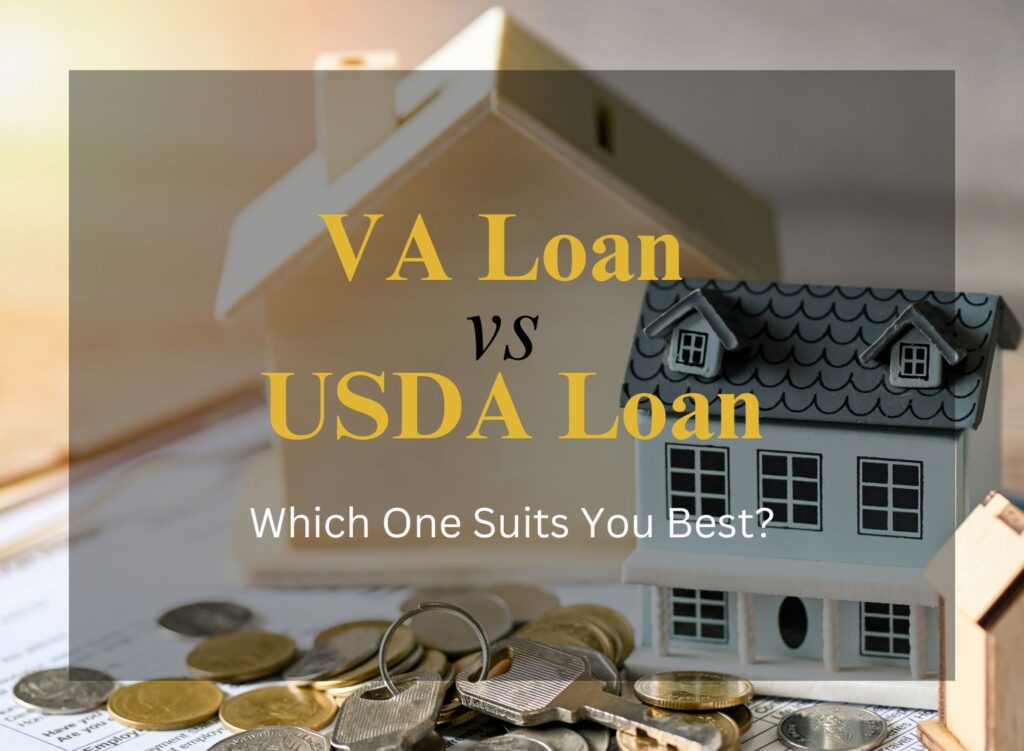In the pursuit of homeownership, a few decisions are as critical as choosing the right mortgage. Mortgage loans are the financial backbone of the home buying process, providing individuals and families with the means to realize their dream of owning a home.
As such, understanding the various types of mortgage options available is essential for anyone embarking on this exciting journey.
In this article, we discuss the two distinct but often confused mortgage programs: VA Loans and USDA Loans. The nature of home financing can be complex, and it’s crucial to comprehend the nuances of each loan type to make an informed decision that aligns with your unique circumstances and homeownership goals.
Don’t let confusion about VA loans and USDA loans slow you down. Let Sprint Funding guide you on the path to homeownership success. Contact us today!
What are VA Loans?

VA Loans, short for Veterans Affairs Loans, are a specialized mortgage program designed to assist veterans, active-duty service members, and certain members of the National Guard and Reserves in achieving the dream of homeownership.
These loans are not directly issued by the VA but are guaranteed by the U.S. Department of Veterans Affairs. This guarantee significantly reduces the risk for lenders, making it easier for eligible individuals to secure favorable home financing.
Eligibility Criteria for VA Loans
To qualify for a VA Loan, prospective borrowers must meet specific eligibility criteria, primarily revolving around their military service history:
- Military Service Requirements
Generally, eligibility for VA Loans is contingent on a minimum period of active-duty military service. The specific service requirements may vary, but they commonly include 90 consecutive days of active service during wartime or 181 days of continuous service during peacetime. Members of the National Guard and Reserves may become eligible after six years of service, with certain exceptions.
- Certificate of Eligibility (COE)
To initiate the application process for a VA Loan, applicants must obtain a Certificate of Eligibility (COE) from the VA. The COE serves as official documentation of the applicant’s entitlement to the program and verifies their eligibility status.
- Credit and Income Requirements
While the VA does not establish stringent credit score or income requirements, individual lenders may have their own standards. A stable income and good credit history can enhance an applicant’s chances of approval and may influence the loan terms offered.
Benefits of VA Loans
VA Loans offer several compelling advantages for eligible borrowers:
- No Down Payment: Perhaps the most notable benefit of VA Loans is the ability to purchase a home with no down payment. This feature makes homeownership more accessible, especially for those who may not have significant savings for a down payment.
- Competitive Interest Rates: VA Loans typically come with competitive interest rates that are often lower than those of conventional mortgages. This can result in lower monthly mortgage payments, saving borrowers money over the life of the loan.
- No Private Mortgage Insurance (PMI): Unlike many conventional loans, VA Loans generally do not require private mortgage insurance (PMI). This eliminates an additional monthly expense for borrowers.
- Flexible Repayment Terms: VA Loans offer flexibility in terms of repayment. Borrowers can choose from various loan term options, such as 15, 20, or 30 years, allowing them to align their mortgage with their financial goals.
- Assistance in Times of Hardship: The VA provides support and assistance to borrowers facing financial difficulties, striving to help them avoid foreclosure whenever possible. This safety net provides peace of mind for VA Loan recipients during challenging times.
Potential Drawbacks or Limitations
While VA Loans offer many advantages, there are a few potential drawbacks and limitations to consider:
- Funding Fee: VA Loans may require a funding fee, which is a one-time upfront cost. The funding fee’s purpose is to help offset the expenses of the VA Loan program. While eligible borrowers can include this fee in the loan amount, it’s important to be aware of this additional expense.
- Property Eligibility: VA Loans can only be used for certain types of properties, such as single-family homes, condominiums, and some manufactured homes. Additionally, the property must meet specific VA requirements, which could limit options in certain markets.
- Use Limitations: VA Loans are primarily intended for purchasing primary residences, not investment properties or second homes. Borrowers must certify their intent to occupy the property as their primary residence.
Key Differences Between VA and USDA Loans
When considering mortgage options for buying a home, it’s essential to understand the differences between various loan programs. Two popular choices for eligible homebuyers are VA Loans and USDA Loans.
Here are some key differences between these two loan options.
Eligibility:

VA Loans
-
- Eligibility Focus: VA Loans are primarily available to veterans, active-duty service members, members of the National Guard and Reserves, and certain qualified surviving spouses.
- Military Service Requirements: Borrowers typically need to meet specific service requirements, such as a minimum period of active-duty service or a certain number of years in the National Guard or Reserves.
- Certificate of Eligibility (COE): Applicants must obtain a COE from the VA to confirm their eligibility status.
USDA Loans
-
- Eligibility Focus: USDA Loans are intended for low to moderate-income individuals and families in rural and suburban areas.
- Income and Location Requirements: Eligibility is determined based on the applicant’s income, and the property must be located in a designated rural area according to USDA guidelines.
Geographical Restrictions:
VA Loans
VA Loans are not limited by geography, meaning eligible borrowers can use them to purchase homes in urban, suburban, and rural areas nationwide.
USDA Loans
USDA Loans are specifically designed for homes in rural and suburban areas. The USDA defines eligible rural areas based on population density and other criteria. Suburban areas near larger cities may also qualify.
Funding Fees:
VA Loans
- VA Loans may require a funding fee, which is a one-time upfront cost. The amount of the fee depends on factors like the borrower’s service history, down payment amount (if any), and whether it’s the borrower’s first VA Loan.
- This funding fee can be rolled into the loan amount if desired.
USDA Loans
- USDA Loans typically have a guarantee fee and an annual fee. The guarantee fee is a one-time upfront cost, similar to the VA funding fee, but the annual fee is recurring and included in the monthly mortgage payment.
- The guarantee fee amount depends on the loan amount and is considerably lower than traditional mortgage insurance.
Credit Score Requirements:
VA Loans
VA Loans do not have a strict minimum credit score requirement set by the VA. However, individual lenders may impose their own credit score standards, which typically range from around 620 to 660.
USDA Loans
USDA Loans generally require a minimum credit score of 640 or higher. Some lenders may accept lower scores with compensating factors, but a strong credit profile is typically necessary.
While both VA and USDA Loans offer unique benefits, they cater to different segments of the homebuying population and have distinct eligibility criteria, geographical restrictions, and fee structures.
Understanding these key differences is crucial in choosing the loan that aligns with your specific financial situation and homeownership goals.
Which is Better: VA or USDA Loan?
One of the common questions that arise when exploring mortgage options is whether a USDA Loan is the same as a VA Loan. While both loans offer attractive features, they are distinct programs designed to serve different segments of potential homebuyers.
Let’s explore the considerations that can help you determine which loan might be better suited to your needs.
Are USDA Loans the Same as VA Loans?
No, USDA Loans and VA Loans are not the same. They differ significantly in terms of eligibility, purpose, and borrower focus:
- Eligibility: VA Loans are available to veterans, active-duty service members, and certain members of the National Guard and Reserves, along with qualified surviving spouses. USDA Loans, on the other hand, are intended for low to moderate-income individuals and families in rural and suburban areas.
- Geographical Focus: USDA Loans are specifically designed for properties located in eligible rural and suburban areas, as defined by the USDA. VA Loans, in contrast, are not restricted by geography and can be used for homes in urban, suburban, and rural locations nationwide.
Factors to Consider When Choosing Between VA and USDA Loans
Location
Your choice between VA and USDA Loans should be influenced by the location of the property you wish to purchase. If you are eyeing a home in a rural or suburban area that qualifies for USDA financing, a USDA Loan may be the better option. If you prefer an urban or non-rural location, a VA Loan would be a more suitable choice.
Military Service
VA Loans are exclusively available to those with a military service history. If you are a veteran, active-duty service member, or eligible member of the National Guard or Reserves, a VA Loan may be a perfect fit due to its tailored benefits. USDA Loans, on the other hand, do not require military service but are income and location-dependent.
Financial Situation
Your financial circumstances play a significant role in choosing between these loans. VA Loans typically require no down payment, making them a fa
ntastic choice if you have limited funds for a down payment. USDA Loans also offer low to no down payment options, but your income level must meet the USDA’s guidelines.
Interest Rates and Fees
Compare interest rates and fees offered by lenders for both loan types. Interest rates may vary, so it’s essential to shop around for the most competitive terms. Consider not only the interest rate but also any upfront funding fees or mortgage insurance costs.
Scenarios for Choosing VA or USDA Loans
- Scenario 1 – Military Service: If you have a military service background, a VA Loan is likely your best choice, provided you meet the eligibility requirements. VA Loans often come with favorable terms, such as no down payment and competitive interest rates, tailored to military personnel.
- Scenario 2 – Rural Property: If you are looking to purchase a home in a rural or suburban area that meets USDA eligibility criteria, a USDA Loan can offer low down payments and attractive terms, making it a strong contender for your financing needs.
- Scenario 3 – Limited Down Payment: If you have limited funds for a down payment but do not meet the VA eligibility criteria, USDA Loans provide an excellent opportunity with their low to no down payment options.
Tips for Making the Right Choice
Choosing between a VA Loan and a USDA Loan is a decision that should be made thoughtfully, considering your unique circumstances and homeownership goals.
Here are some practical tips to help you make the right choice:
Consult with a Mortgage Expert
Mortgage professionals and lenders are valuable resources. Reach out to them to discuss your financial situation and goals. They can provide personalized guidance, help you understand the specific terms of each loan, and assist you in determining which one aligns best with your needs.
Evaluate Your Location
Begin by assessing the location of the property you intend to buy. If it’s in a rural or suburban area that qualifies for USDA financing, explore the benefits of a USDA Loan. If the property is in a more urban or non-rural area, a VA Loan might be a better fit.
Consider Your Military Service History
If you have served in the military, review your eligibility for a VA Loan. VA Loans offer tailored benefits for veterans, active-duty service members, and certain members of the National Guard and Reserves. Take advantage of these benefits if they apply to you.
Assess Your Financial Situation
Carefully evaluate your financial position. If you have limited funds for a down payment, both VA and USDA Loans offer low to no down payment options. Consider which loan’s income and credit score requirements align better with your financial profile.
Long-Term Goals
Think about your long-term goals for homeownership. Consider factors such as your anticipated length of stay in the property, future income changes, and any plans to upgrade or relocate. These considerations can help you choose a loan that suits your long-term plans.
Final Thoughts
The decision between a VA Loan and a USDA Loan is not one-size-fits-all. Each loan type has its own set of advantages and eligibility criteria. The key points to remember are:
- Location Matters: Your choice should align with the location of the property you want to purchase.
- Military Service: If you’re a veteran or currently serving in the military, VA Loans offer unique benefits.
- Financial Fit: Assess your financial situation and choose the loan that best suits your income, credit profile, and down payment capabilities.
Ultimately, there’s no universally better loan type; it depends on your individual circumstances and goals. Take the time to explore your options thoroughly, consult with experts, and make an informed decision. Homeownership is a significant step, and the right loan can make it a more achievable and rewarding endeavor.
Ready to find the right loan for your homeownership plans? Our expert team at Sprint Funding is dedicated to helping you understand VA and USDA Loans. We’ll guide you to the best option suited to your specific needs and goals.
You don’t have to go through the complex process of home financing on your own. Reach out to Sprint Funding today, and we’ll help make your home ownership dreams come true.






